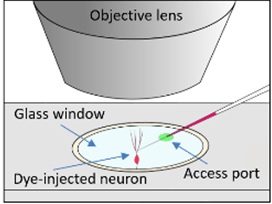Chronic Cranial Window for Drug Application and Electrophysiology in Live Animals (No. 0051)
|
|
|
<< Back to all technologies |
Summary
A novel cranial window with an access port for medical research.
The propelling factors for the growth of the drug discovery market include the rising burden of a wide range of diseases (such as cardiovascular and CNS-related disorders), rising healthcare expenditure, and upcoming patent expiration of blockbuster drugs. In pharmaceutical drug research, versatile and cost-effective techniques for studying neurons and neuronal activities in awake animals over a long period of time have been long sought. A reliable and economical technique for studying brain diseases on a cellular level in vivo and evaluating the effects of drugs on brain diseases has been long desired. However, with known techniques, although the brain is kept sterile, the brain region of interest is not accessible for local drug application or electrophysiology. Here we present a promising cranial window developed by a group of researchers led by Prof. Bernd Kuhn.
Applications
- Drug Screening
- Visualization of Neurons
- Exogenous Gene Expression
Advantages
- Repeated, Local Manipulations
- Reducing Infection Risk
- Low Cost, Simple Procedure
Technology
The technology is based a glass cranial window with an access port sealed with biocompatible silicone that enables long-term high-quality imaging with repeated cellular manipulations. Specifically, a cranial window with an access port for medical research or treatment, includes: a sheet-shaped member configured to be installed as a cranial window on an outer brain skin of an animal subject through an opening in the skull, the sheet-shaped member having an optically transparent window therein or in entirety thereof to allow optical imaging into a brain of the animal subject; and an access port in the sheet-shaped member for allowing sterile insertion and removal of an accessing member having a sharp tip, the access port being configured to be self-sealing when the accessing member is removed.
Media Coverage and Presentations
CONTACT FOR MORE INFORMATION
![]() Graham Garner
Graham Garner
Technology Licensing Section
![]() tls@oist.jp
tls@oist.jp
![]() +81(0)98-966-8937
+81(0)98-966-8937






